Intel Optane vs AMD StoreMi – What is the Difference?
Ever since the time of big and bulky magnetic drives back in the day, computer users have always craved both more storage as well as faster storage. The venerable mechanical hard drive is still the backbone of most of our storage needs, providing large storage space for relatively low prices. Solid State Drives or SSDs have taken the world of computer storage by a storm due to their much faster speeds and general convenience but they are still significantly more expensive than a hard drive if we compare them on the basis of storage capacity. Generally, most users are perfectly fine with the idea of pairing a smaller, faster SSD for their operating system, with a large bulky HDD for mass storage of their bigger data like games and media, etc. However, the rapid technological advancements in the field of storage have brought us some interesting ways to increase the speed of a standard mechanical hard drive.
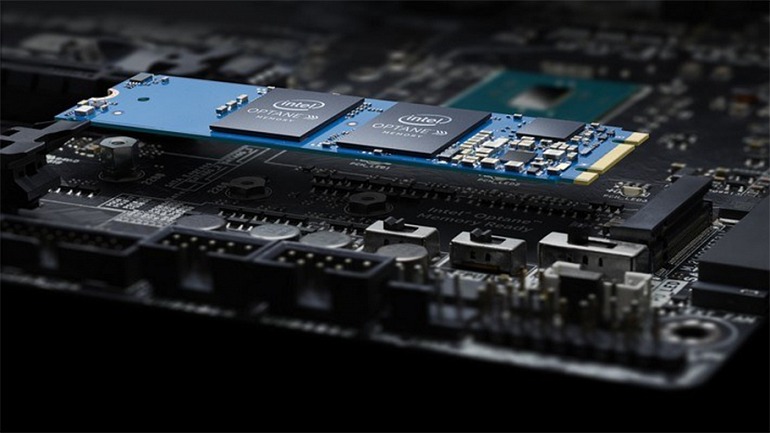
This is where the techniques of cache acceleration come in. Such approaches aim to bridge the speed gap between the hard drive and the SSD in order to provide the user with a better experience in terms of both capacity and speed. The two most popular technologies that enable this, Intel Optane and AMD StoreMi, work in a similar fashion. The main aim of HDD acceleration is to use a small amount of SSD cache (usually high-speed NVME memory) to speed up the hard drive in many scenarios. The NVMe cache is used to store the most recurrent files of the computer as it is being used.
Need for HDD Acceleration
So why is the technology of HDD acceleration actually needed? While it is a reasonable approach to pair a distinct SSD for the OS with a large mechanical HDD for mass storage, this approach separates the two drives into their own distinct ecosystems. While all the OS and related applications that are being read from the SSD will be fast and responsive, the other data would have to be accessed separately from a hard drive which would introduce delays and slowdowns, hurting the overall experience. Not to mention, the smaller SSD would probably not be able to hold many games, which is a major use-case for most people nowadays. The SSD’s speed would not improve the experience of the games that are stored on the hard drive, and thus it would be limited to general system responsiveness.
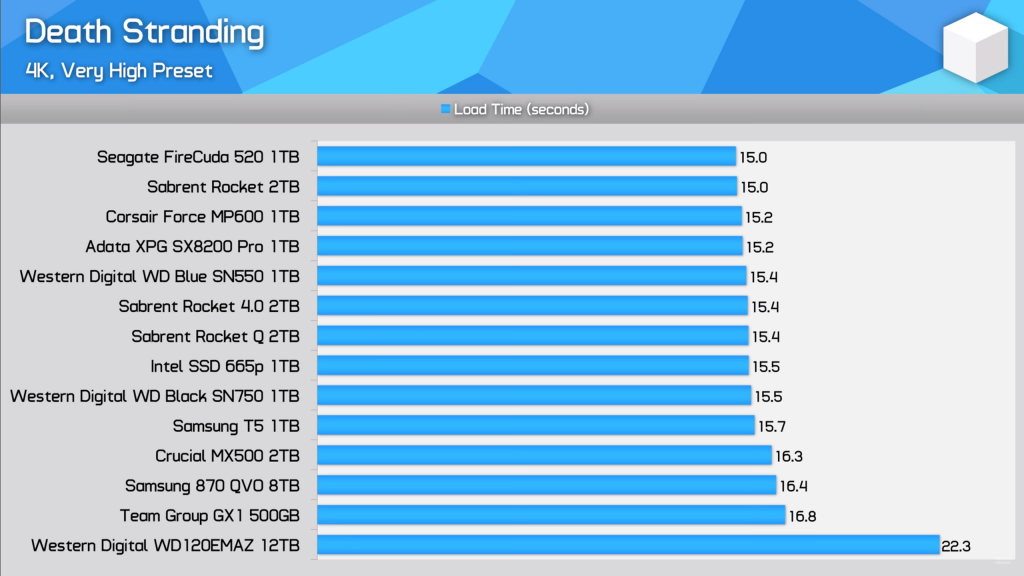
Enter the acceleration technologies. With techniques like AMD StoreMi and Intel Optane, the two ecosystems no longer remain distinct, rather they essentially blend into one another to give the user the best of both worlds. Both of these technologies integrate different storage solutions to improve the speed of the hard drive by using a small high-speed NVMe cache which holds the most recurrent files of the PC. This improves the speed and responsiveness of the hard drive significantly, while also retaining the massive storage space of the hard drive for more practical purposes than a traditional smaller SSD. Let’s dive deeper into both of these technologies to see what makes this possible.
What is Intel 3DXPoint/Optane?
As we discussed in our ultimate SSD buying guide, 3DXPoint (3D Cross Point) is an emerging new technology that has the potential to be faster than any consumer SSD available now. This is a result of a partnership between Intel and Micron (one of the world’s leading flash memory manufacturer), and the resulting product is being sold under the “Optane” brand of Intel. Optane memory is designed to be used as a caching drive in combination with a slower hard drive or SATA SSD, which is exactly what makes it ideal for cache acceleration. This allows for higher speeds on those slower drives while retaining the larger capacities. Optane technology is still in its infancy but it is becoming more and more popular in mainstream PCs. The technology promises several quality-of-life improvements for users of traditional hard drives that would indeed be beneficial to them without breaking the bank and buying an expensive large SSD.
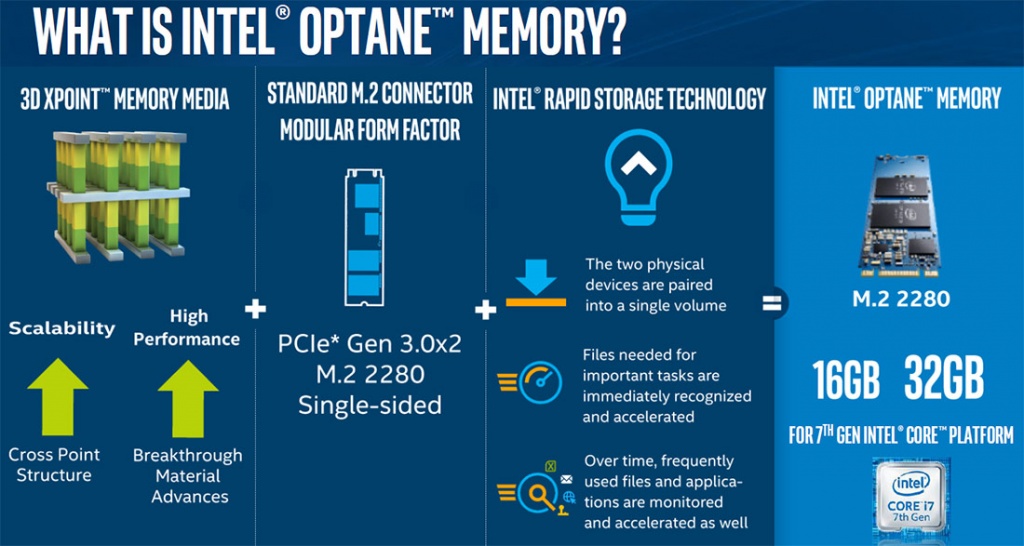
The Optane technology works in conjunction with Intel SRT which stands for Smart Response Technology. This technology was developed by Intel with the launch of its SSDs around 4 years ago, and it associates an SSD unit with another large storage unit (either HDD or SSHD) so that the first one acts as a large cache of data to allow quick access to recurring files. This is why the SRT technology scales well with the speed of the memory associated with the hard drive.
Unlike traditional RAM, the Optane module is of non-volatile nature, which means that the data is conserved even after the power is cut off. The Optane module is able to memorize which files are required for each program to function optimally, and it always loads up the required files in the faster cache memory to speed up the experience.
What is AMD StoreMi?
AMD’s approach to this cache acceleration technology is known as StoreMi which stands for Store Machine Intelligence. It is based on a software known as FuseDrive, which merges an SSD, an HDD, and a part of RAM in a single storage disk. Using FuseDrive, the resulting unit can approach the speeds of an SSD, while retaining the full capacity of a traditional Hard Drive. StoreMi is similar to Intel Optane in this regard as it also uses multiple drives to accelerate the traditional hard drive using the smaller flash drive as cache.
StoreMi actually makes use of advanced machine learning intelligence and uses an automatic tiering technology that analyses the data blocks, and then moves the most frequently accessed blocks to the faster storage tier. StoreMi unites the storage units in a large block and then makes tiers within those blocks in a systemized manner. RAM is assigned the highest tier due to its speed, then SSD comes in at the second tier and HDD at the very last tier.
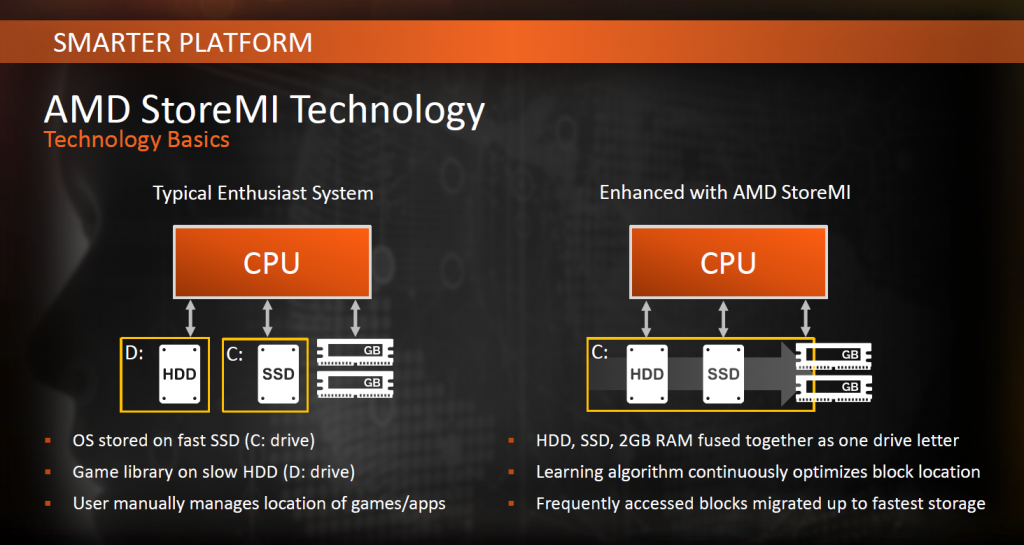
Using the aforementioned machine learning intelligence, the StoreMi technology learns which files are heavier and sends them to the SSD from the HDD while also going through the RAM. The RAM uses a cache, so the most frequently used programs from that data will be stored inside that cache. This also means that this caching technology gets better once the user starts using it frequently and for a prolonged period of time.
Similarities
While the two technologies take different approaches towards this solution, their end goal is pretty much the same. Both Intel Optane and AMD StoreMi use multiple storage devices to accelerate the larger storage device (usually a hard drive) in order to increase the speed of the files on that drive while maintaining the bigger capacity of that hard drive. Both of these approaches make use of a smaller high-speed cache to store frequently accessed programs and files so that the user does not have to wait for the slower hard drive to perform these functions.
The similarities do not end there, as both of these technologies involve the merging of all the storage drives involved (usually two) to form a single unified drive with one drive letter. That drive has the capacity of the original hard drive (or more in the case of AMD) but manifests higher speeds due to the onboard cache now. Both of these technologies have the potential to get better with more and prolonged usage as it is easier for the system to “predict” which files and programs should be in the cache for quick access, all thanks to deep learning features.
Differences
There are quite a lot of differences between the two approaches as expected. Here are some of the more important ones that may be important to the average consumer:
- Intel’s solution is a hardware-software combination that requires the purchase of an additional Optane module, but AMD’s solution is purely a software one.
- Intel’s Optane memory is a cached storage option, while AMD’s StoreMi is a tiered storage solution.
- Optane only accelerates the read speeds of the HDD, while StoreMi being a tiered solution accelerates both the read speeds as well as the write speeds.
- In case of any hardware failure, AMD’s solution will not be able to protect any data and all the underlying data will be lost. In the case of Intel Optane hardware failure, only the recent data will be lost.
- AMD StoreMi is limited to 256 GB of tiered SSD storage, while in Opotane the limit of cached storage is 64 GB. There is also the option of a 1TB upgrade for AMD StoreMi using FuzeDrive for AMD Plus.
- The Intel Optane solution offers excellent data mirroring options with which users can easily mirror a volume within a drive. This functionality is not available in AMD StoreMi unless a separate hardware RAID option is chosen.
- StoreMi is probably a better option for people who are not looking for redundancy or backup support. StoreMi offers the user more collective storage than Optane by combining the storage capacities of both the SSD and the hard drive. It also operates faster than a cache as it uses far fewer CPU cycles under heavy loads.
- The Optane implementation is done at a ROM level. This means that any corruption or damages to the OS will not have any effect on the functionality of the memory. StoreMi runs at the bootloader and kernel driver level so it will have components that run after the OS is loaded.
- StoreMi is less dependent on the BIOS than Optane which requires the correct BIOS version and support.
- Intel Optane SRT is only compatible with the 200 series or higher chipset while AMD StoreMi is only compatible with the 400 Series chipset.
- If everything else is considered equal, the Optane storage solution does provide faster-accelerated state performance than StoreMi does with a SATA SSD, and Optane over NVMe should be even faster. However, the differences are not that dramatic and it’s hard to see the difference in the real-world performance.
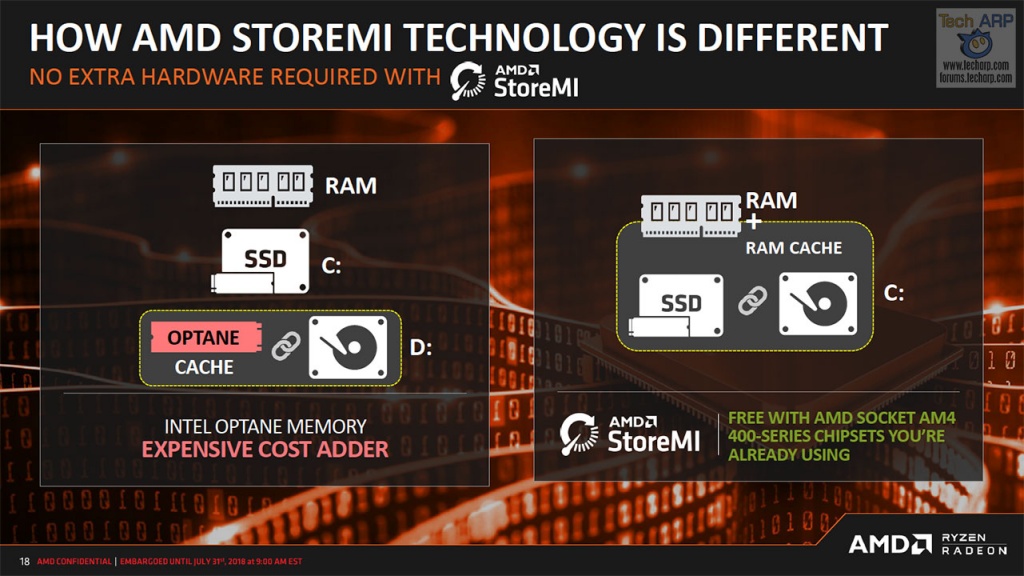
Which one is better for you?
If you are planning to accelerate your hard drive with one of these two technologies, then it might be easier than you think to decide between them. If you already have an Intel-based system, the only way for you to use the cache acceleration features is to install an Intel Optane module. If you already have an AMD based system, the only way for you to get these features is through StoreMI.
If you are in the market for a brand new system and are yet undecided on the platform, it is important to weigh both these technologies and compare their pros and cons. In terms of raw speed, the Intel Optane module provides a bit more speed than StoreMi, but it is barely noticeable in the real world. However, if you want decent support for data mirroring, then you should definitely look towards Intel’s solution which is more suited to this type of use-case. StoreMi is better if you want a higher overall storage capacity and do not want to buy a separate hardware module to use this feature.
Final Words
Hard drives are still the biggest and most prevalent storage medium in modern computing despite the rise of SSDs several years ago. The biggest hurdle in the dominance of SSDs has been their price, which made it unsuitable for most users to make a system without any form of HDD storage in it. Now, with technologies like Intel Optane and AMD StoreMi, users can accelerate the hard drive by using a small cache that stores the most frequently accessed files and programs, thus providing users with the best of both worlds.
Intel’s Optane and AMD’s StoreMi solutions work in similar ways but there are some key differences between them too. It is important that the user weighs the pros and cons of both of these approaches against each other and then decide the most optimal route for them. Both of these technologies are very exciting and are evolving continuously so it will be interesting to see what improvements both Intel and AMD bring to the table next.





